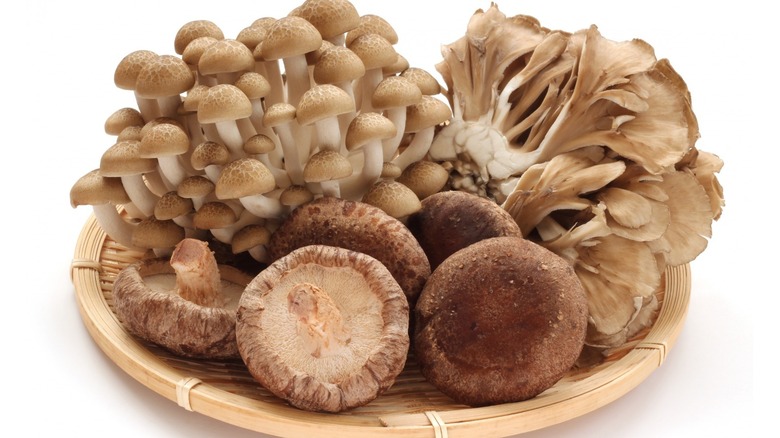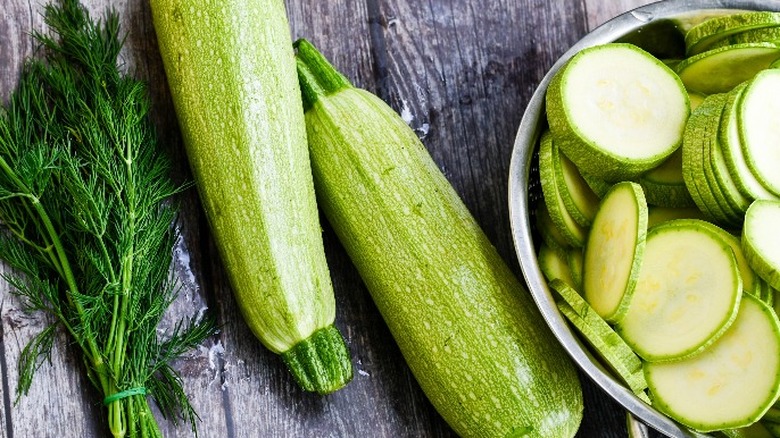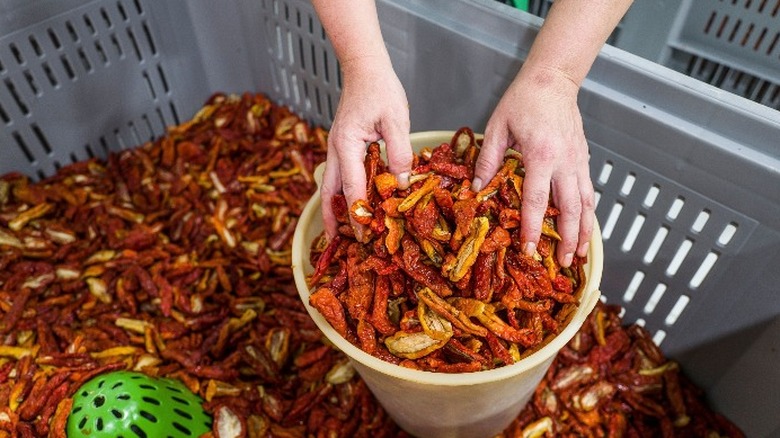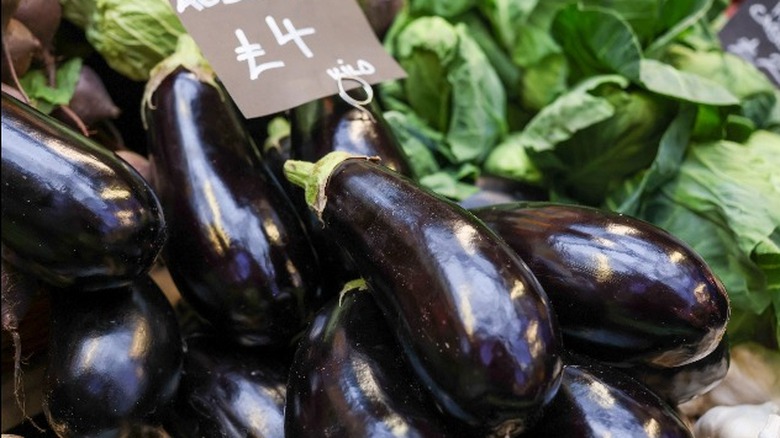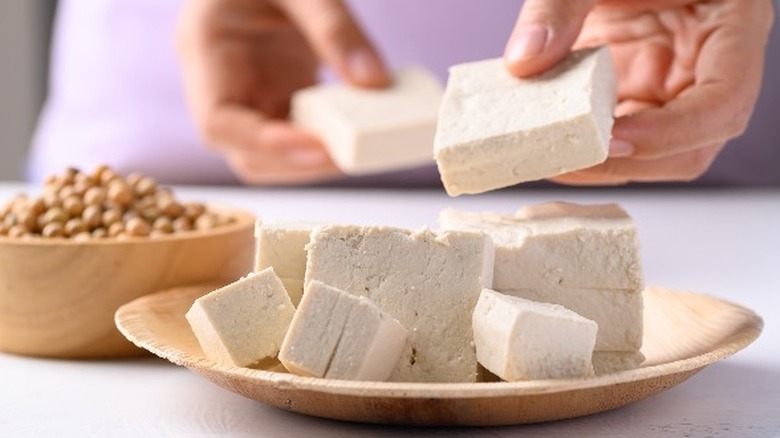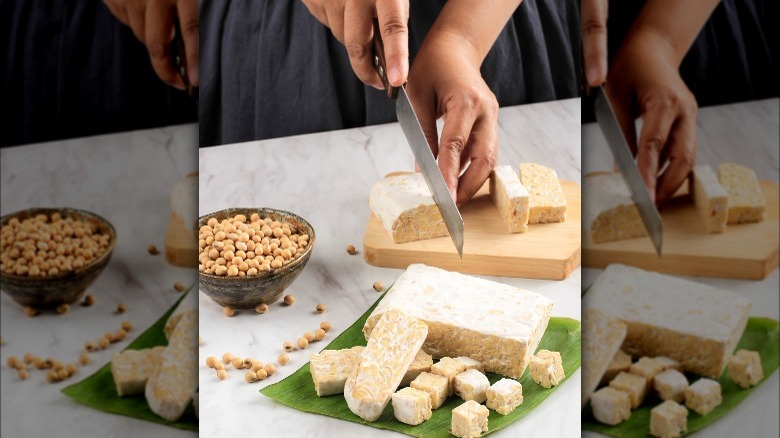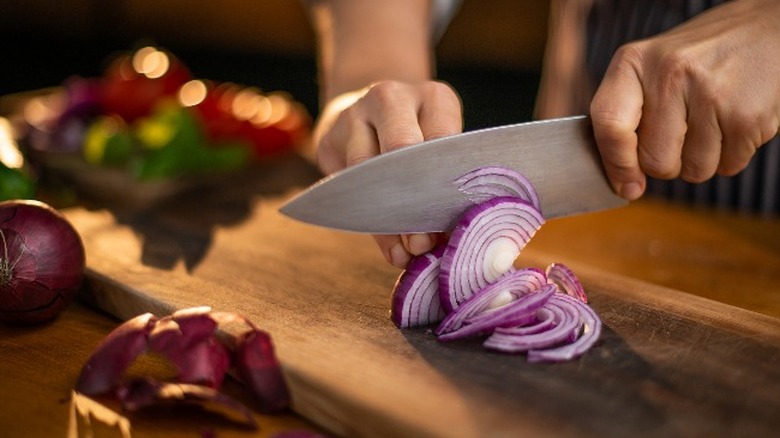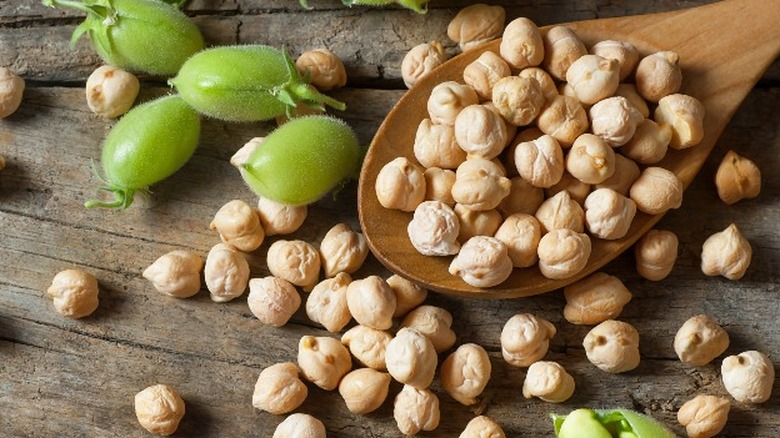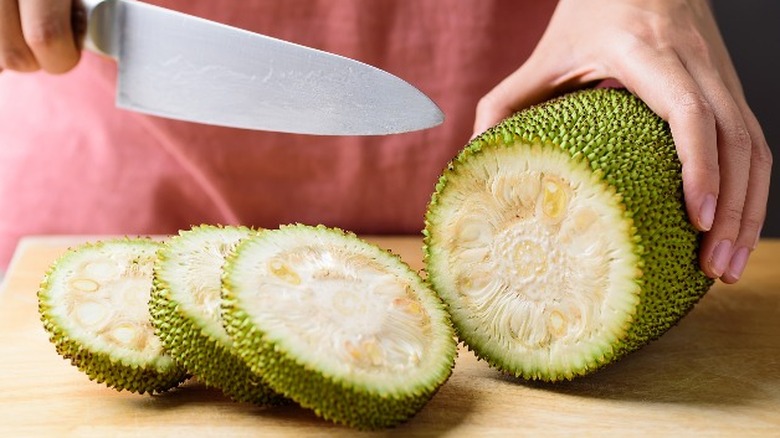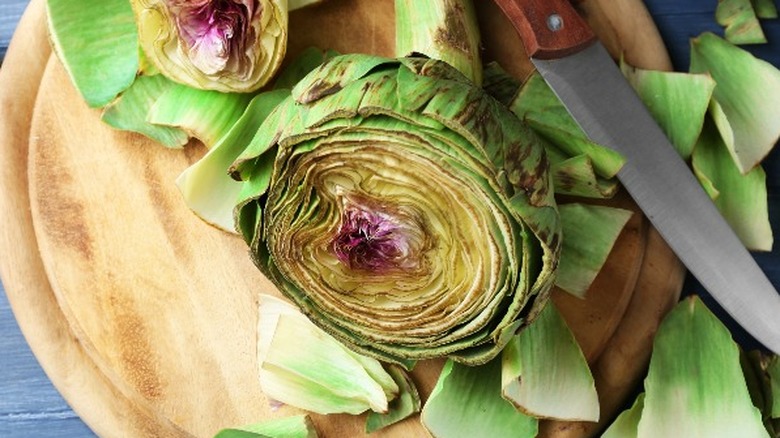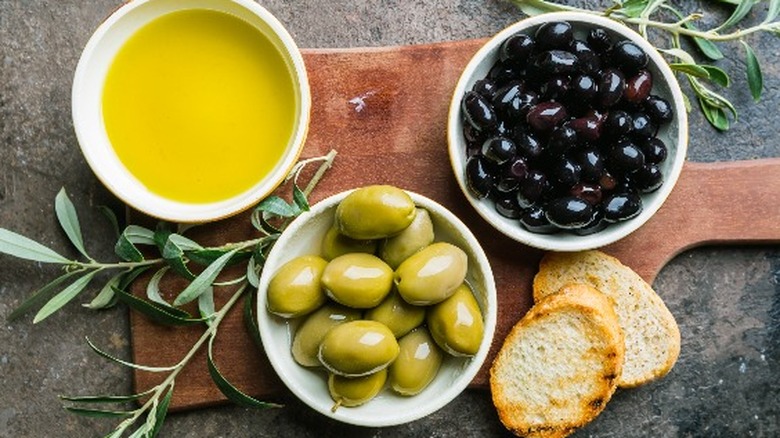10 Best Substitutes For Mushrooms
We may receive a commission on purchases made from links.
If you've ever described mushrooms as having a meaty texture, you're not alone. MasterClass even goes so far as to call mushrooms "the meat of the vegetable world." Their distinct earthy flavor can act as a base in many dishes or become the main character on your plate with the proper preparation. The best way to cook with mushrooms, some say, is to saute or grill them, but others prefer using them as a building block of flavor. However, the taste and texture of this fungus simply isn't for everyone.
You shouldn't eat just any mushroom — about 3% of these members of the fungi kingdom are toxic to humans, per the Cleveland Clinic. And around 1% of the population is allergic to mushrooms no matter what kind they are (via The National Library of Medicine).
People tend to love or hate mushrooms, although there are as many varieties as there are opinions on this ingredient. If you fall into the camp of folks who pick mushrooms off their plate, consult this list for substitutions that are equally flavorful and savory.
1. Zucchini
If you'd rather skip the mushrooms included in your recipes, give zucchini a try. The summer squash is slightly sweet, but it takes on the flavor of whatever you prepare it with and has a similar (but slightly less chewy) texture as cooked mushrooms.
This member of the squash family grows mostly in the summer months. It's a great compliment to pasta and other dishes with complex flavors and meaty textures, but it can also stand on its own as an entree or side dish.
Apart from its role as a mushroom trade-in, one of the reasons you should eat more zucchini is how healthy this versatile ingredient is. Zucchini has high levels of immunity-building vitamins, like vitamins A and C, and is a prime provider of antioxidants and anti-inflammatories. People looking to cut down on carbohydrates often substitute zucchini for other, carb-heavy foods like pasta.
Feel free to use the same amount of zucchini that your mushroom-centric recipe calls for. But don't cook it as long, because the zucchini will wilt and become mushy. For example, if you're stir-frying zucchini, take it off the heat sooner than you would with mushrooms.
2. Sun dried tomatoes
Sun dried tomatoes get plucked from the vine at the peak of ripeness and dried, either in the sun or in a dehydrator or oven. Because this process absorbs 82-90% of the moisture from the fruit, per Daring Gourmet, sun dried tomatoes take on a chewy texture that can serve as a top-notch substitute for mushrooms.
If you choose to go the sun dried tomato route in your cooking, be sure to purchase a variety that isn't packed in oil. This will ensure you get a similar, shroomy texture. And if you choose to make them yourself, you can have control over every step of the process, from the variety of tomatoes you use to the way they're stored once you've dried them.
Sun dried tomatoes pack a big flavor punch. Like mushrooms and zucchini, they're ideal for pastas, like this creamy sun dried tomato pasta recipe. They also stand out as a pizza topping.
You may want to use fewer sun dried tomatoes in a recipe than you typically would mushrooms. They don't have to be cooked, but if you do decide to do so, they can handle a lot of heat.
3. Eggplant
Eggplant has a subtle flavor and meat-like texture, but getting it to that point can be difficult. If overcooked, eggplant takes on moisture and becomes soggy. The trick to substituting eggplant for mushrooms is to cook the ingredient just to the point of doneness before removing it from the heat.
The surprising truth about eggplant is that it is a fruit — more specifically, a berry. Like zucchini, this vibrant purple fruit is extremely nutritious. Eggplant is high in antioxidants and fiber and can reduce the risk of heart disease.
Eggplant, like mushrooms, is a divisive character in the produce community. Some people love it, while others loathe it. Many chefs use it as a supplemental ingredient to build flavor in recipes, but it can also be the main part of a dish.
To achieve a similar quality, cut the eggplant, which is large and oblong, into smaller, shroom-sized pieces. Since they're similar in texture, you can use it in the same volume as you would mushrooms. But, as previously stated, don't cook your eggplant too long. It'll get mushy far more quickly than mushrooms.
4. Tofu
Tofu is the chameleon of the culinary world, particularly in vegetarian and vegan cuisine. The spongy soy product doesn't have much of a taste on its own, but it absorbs other flavors quite well. Super firm tofu specifically makes a great substitute for mushrooms. Tofu is high in protein, which also makes it a great meat substitute.
Food Champs ranks tofu as the number one substitute for mushrooms. For the best results, press out all of the liquid in your tofu block before using it. You can do this by wrapping towels around your block of tofu. Place something heavy on top, and leave it there for an hour or so. Drain the liquid off, and you're ready to start cooking.
To achieve a mushroom-like texture, bake or fry your tofu with savory seasonings and umami flavors. Be careful not to cook it too long, because it may fall apart. You can use the same amount of tofu in your recipe as you would mushrooms, but it's also OK to cut back if you aren't sure — large quantities of the spongy texture might be too much for a tofu novice.
5. Tempeh
Tempeh, a firmer cousin of tofu, can stand in for mushrooms because of its firm, meaty texture. In stir fries and other mushroom-heavy dishes, tempeh yields a chewy bite with earthy flavors.
This healthy alternative is made of compressed, fermented soy beans and has a slightly stronger flavor than tofu. While both of these options are quite versatile, the difference between tempeh and tofu lies in the way they're produced and the resulting textures. When sliced thinly, tempeh bears a striking resemblance and flavor to mushrooms.
Like tofu, there are a multitude of ways to prepare tempeh. It can be sliced and baked, marinated and steamed, crumbled, sautéed, or cooked any other way you can imagine. Eat it on a sandwich, in pasta, or on its own. Don't hold back — the more tempeh you add, the meatier your bite will be.
6. Onions
If mushrooms don't please your palate, onions might be able to step in. Although they have a different taste — often sweeter or spicier than mushrooms — onions can compliment your dish with their complex flavors and heavenly aromas.
For recipes that call for mushrooms as a topping, like burgers or pizza, caramelized onions make a great replacement. They pair well with many foods and are simple to prepare, though they do require a bit of patience. Onions can jazz up the flavor of gravy traditionally made with mushrooms and stand out among other vegetables. And, if you find yourself avoiding them because they burn your eyes when slicing them up, fret not: there's a trick to stop you from crying when chopping onions.
Sauteed, fried, baked, or stewed, onions can take your cooking to a new height. They will also perfume your kitchen with rich scents that will make you forget that mushrooms ever existed. But don't go crazy. You'll taste onions in a dish a lot more than you will mushrooms.
7. Garbanzo beans
This compilation of mushroom substitutes wouldn't be complete without an enthusiastic shout-out to garbanzo beans. People usually associate the garbanzo bean (also known as a chickpea) with hummus because it acts as a base in the popular dip. But the small bean is incredibly versatile.
Garbanzo beans are nutty in flavor and have a soft texture. Their taste profile doesn't directly match with mushrooms per se, but the two pair well with a wide range of other flavors. Two types of garbanzo bean exist — the smaller and darker kind and its plump, soft, and creamy sibling. Either work as a replacement for mushrooms.
There are plenty of tasty ways to use a can of chickpeas. You can cook them in stews and stir fries, bake them until crispy, or toss them in a salad. If you're feeling lazy, you can even eat them straight from the can. Don't stress about cooking them, but you won't regret it if you do. They'll absorb all the flavor of your dish. You can use as many chickpeas as you would mushrooms in your dish.
8. Jackfruit
Vegans, vegetarians, and even carnivores everywhere are starting to see the bountiful culinary potential of jackfruit. Depending on its ripeness, this ancient, exotic fruit can be sweet or savory. When ripe, the jackfruit has a tropical, sweet taste, like a mango or pineapple. Before it reaches ripeness, the flavor is more neutral, very much like a mushroom.
Jackfruit has a large, thick, bumpy shell. But when sliced open, a sinewy, flesh with a meaty texture is revealed — a perfect substitute for mushrooms.
Jackfruit is widely known among vegetarians and vegans as a meat replacement because of its texture, which can closely mimic pulled pork or shredded chicken. But this fruit, which can weigh up to 40 pounds on its own according to Cleveland Clinic, can be found in many stores pre-cut into chunks that will easily stand in when a recipe calls for mushrooms. The flavor is more neutral than that of mushrooms, but seasoning or marinating jackfruit properly will give you a similar result.
You'll need to cook jackfruit longer than you would mushrooms to achieve the right texture and flavor. But use the same volume as you would in your original recipe.
9. Artichoke Hearts
If you're looking for a quick and easy mushroom substitute, go for canned artichoke hearts. They're ready to go straight out of the can, and make a perfect topping for pizza and an excellent addition to salads and pastas. Artichokes and mushrooms are often used in place of one another — this dip recipe from The Boat Galley is even designed to be made with either ingredient.
Like most of the items in this list, artichokes have a slightly chewy texture that borders on meaty. They don't have a particularly strong flavor, but they tend to take on the tastes of the ingredients they're prepared alongside.
If you can't find the canned variety, you can use a fresh artichoke, but be warned — they take a little time. Whole artichokes require cleaning and prepping, which can be tricky. To steam them, first trim off the upper third of the bulb and cut off the stem. To use the hearts and the stems, remove all the leaves, minus the ones around the heart. Remove the remaining green parts and any prickles, and cut down to the white flesh. Then, soak them for an hour.
It may be a good idea to cut down on the number of artichokes you use in place of mushrooms, as they do have a stronger flavor.
10. Olives
Olives probably don't leap to mind as an ingredient that's similar to mushrooms. They have a briny, salty taste, as opposed to the neutral, earthy tones of mushrooms. But the texture is spot-on.
If you're planning to keep olives on hand, be wary of how you store them. Experts recommend keeping olives in a nonmetal container to preserve their flavor. Keep them stored in their brine (which you can also use in your cooking) to make sure they stay crisp and flavorful. Follow these guidelines, and your stash of olives can last up to two months in the fridge.
Be warned that if you substitute olives for mushrooms, you may want to alter your recipe slightly. Use fewer olives than you would mushrooms, as they have a high salt content and a bold flavor, and season carefully. Plus, you don't have to worry about cooking olives — add them to your dish at the last minute, and they'll still taste great.
